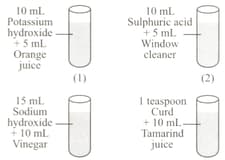A class science teacher arranged the following set of test tubes.

Which of the following observations is correct when these solutions were tested with different indicators?


Important Questions on SOF National Science Olympiad
Which of the following changes (i-vi) from the given list cannot be reversed?
(i) Breaking of an earthen pitcher.
(ii) Freezing of ice-cream.
(iii) Falling of bucket with water.
(iv) Filling of bucket with water.
(v) Rusting of a bicycle.
(vi) Digestion of food.
Which of the following statements is incorrect?
Statement 1: A salt is produced when an acid is neutralised by a base.
Statement 2: A salt can be acidic, basic or neutral.
Which of the following statements is/are correct?
I. The process of sedimentation can be made slower by loading.
II. Centrifugation is used in laboratories for separating plasma and platelets from blood.
III. A solution in which some more solute can be dissolved at fixed temperature is called saturated solution.
IV. Winnowing is used to separate husk and hay from grains.
Match column I and column II and select the correct option from the given codes.
|
Column I |
Column II (Uses) |
||
| P | Baking Soda | (i) | In making fire-works |
| Q | Nitre | (ii) | As a fungicide |
| R | Blue vitriol | (iii) | In purification of water |
| S | Phitkari | (iv) | In fire extinguishers |
A few changes are given below:
a. Making almirah from wood
b. Galvanisation of an iron pot
c. Making an aeroplane from a paper
d. Formation of acid rain from air pollutants
e. Photosynthesis
f. Breaking of vase
Classify these changes into:
I. Irreversible - physical change.
II. Chemical change.
III. Reversible-physical change.
Namita was given four liquids, and . These liquids were added to four beakers filled with water separately and stirred. She recorded her observations as follows:
Liquid waterImmiscible liquids
Liquid waterMiscible liquids
Liquid waterImmiscible liquids
Liquid waterMiscible liquids
What could liquids and respectively be?
Pick the odd one out from each series given below and select the correct option.
(i) Muga, Kosa, Cashmere, Tussar
(ii) Larva, Pupa, Silk moth, Tadpole
(iii) Patanwadi, Marwadi, Pashmina, Lohi
